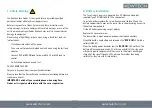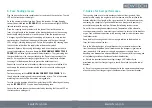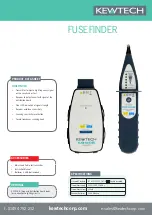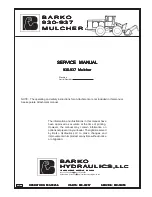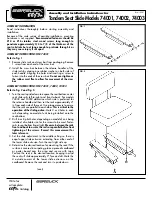
6. Fuse finding process
Plug the transmitter into the socket under test and switch the socket on. The red
LED on the transmitter should light.
Go to the consumer unit or fuse box. Turn on the receiver. A steady beeping
tone will be emitted and the ‘RCVR ON’ LED on the receiver will light GREEN to
indicate automatic scanning mode.
Place the scanning head in contact with the face of the circuit breakers or
fuses at a right angle to the direction of the breaker body and run the scanning
head steadily along the row(s) of circuit breakers. When the receiver detects
a stronger signal the frequency of the beeping will increase to a very rapid or
continuous tone, the pitch of the beeper will increase and the signal strength
LEDs will light, climbing the bar graph. Ensure that you place the scanning tip on
the circuit side rather than the supply side of the breaker switch.
Important: Because the scanning technology used is comparative, on the first
scan of the breakers or fuses on a board the ‘MAX SIGNAL CORRECT FUSE
FOUND’ LED will often light for several different breakers. This is indicating that
the signal detected is the strongest found so far. Do not stop scanning at this
point as it may not be the strongest signal there is. It is essential to continue
scanning all of the breakers that may protect the outlet under test.
Repeat the scan of the row of breakers without pressing the reset button. With
each sweep the receiver will automatically adjust its sensitivity and disregard
weaker signals.
Continue scanning until the ‘MAX SIGNAL CORRECT FUSE FOUND’ LED is
lit only when the scanning head is over one breaker or fuse. This is the breaker
protecting the circuit that the transmitter is plugged into.
Turn the circuit in question off and the signal strength LEDs will extinguish leaving
only the ‘RCVR ON’ LED lit and a slow steady beeping tone.
Confirm the correct breaker has been selected by checking that the red LED on
the transmitter is no longer lit.
7. Advice for best performance
The scanning head uses a ferrite transducer to detect the signal and, like a
portable radio, varying the angle at which the receiver is held in relation to the
breaker will affect the strength of the signal received. As the receiver works by
comparing the strength of signal received from one breaker with another it is
essential to compare like with like. Observe the following for best results.
Do not let the scanning head wander around. To operate well the automatic
scanning memory needs a consistent signal so keep it in touch with the breakers
as you scan and keep the position of the scanning head a similar distance from
the breaker switch .
Keep the black scanning head at the same angle relative to the breakers or
fuses for the duration of the test.
Due to the differing designs of circuit breakers it may sometimes be unclear
from the above procedure which of two breakers the strongest signal comes
from, particularly if the maximum strength signal appears to come from a
boundary area between two adjacent breakers. In the event of this occurring one
of the following variations should enable clear identification.
a) Rotate the receiver (without resetting) through 360º to identify the
orientation in which the strongest signal is found. Reset and re-scan the row of
breakers.
b) Reset the receiver and test at the opposite (to the common boundary) edge
of each breaker. The strongest signal should come from the correct breaker.
kewtechcorp.com
kewtechcorp.com


